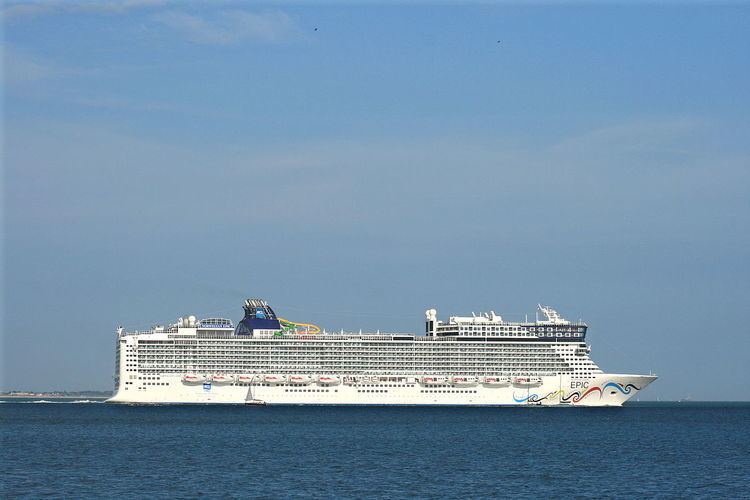Ordered 9 September 2006 | ||
 | ||
Name F3 I (2008–2010)Norwegian Epic (2010–present) Route Europe (Roundtrip from Barcelona Since Summer 2011) (Roundtrip from Rome & Marseille as well in Summer 2012)Caribbean (Roundtrip from Port Canaveral Since 2010) Builder STX France Cruise SA, Chantiers de l'Atlantique shipyard, Saint-Nazaire, France | ||
Norwegian Epic is a cruise ship of the Norwegian Cruise Line built under that line's F3 Project by STX Europe Chantiers de l'Atlantique shipyard in Saint-Nazaire, France. When built it was the third largest cruise ship in the world.
Contents
Two ships in this Epic class were ordered by NCL in November 2006, with an option for a third vessel that was not exercised. A dispute between NCL and STX initially resulted in the construction of both ships being placed on hold until a new agreement was reached. That called for completion of the first ship would be completed; the second ship was cancelled in 2008. The sole remaining ship, Norwegian Epic, was delivered to NCL on 17 June 2010.
After completion and acceptance, the Epic sailed on Thursday 24 June 2010 from Southampton to New York.
Overview
The Norwegian Epic surpasses the Breakaway-class as NCL's second largest ship. Because Norwegian Escape is the largest in the NCL fleet 155,873 GT. Norwegian Epic represents the "third generation" of Freestyle cruising vessels and its size allows NCL to have a ship that is in the "mega-class" of their competitors at Royal Caribbean International and Carnival Cruise Lines, though still 32% smaller by gross tonnage than Royal Caribbean's Oasis of the Seas and Allure of the Seas, the world's largest and longest passenger vessels.
The Epic has 4,100 passenger berths, with all outside cabins having balconies. Staterooms feature curved walls and unusual bathroom arrangements where each area is separate, including the toilet with its glass door, the shower with its glass door, and a small modern vanity sink in the stateroom. The Epic introduced 100 square foot interior studio cabins for solo passengers, including a shared private "Living Room" for socializing. NCL had stated that this ship would have 60% more passenger space than their then-largest ships.
Norwegian Epic's Aqua Park' has the only tube and bowl water slide at sea. The ship also has a rappelling wall and a three-lane bowling alley. It also has a 17 °F (−8 °C) Ice Bar where the drinks are served in ice glasses and patrons wear parkas.
The F3-class ship was built by STX Europe at the Chantiers de l'Atlantique shipyard in Saint-Nazaire, France. The last ship delivered to NCL that was not at least partially built at a German shipyard was the Windward of 1993. Since that date and until this order, NCL's newbuildings have been built at the German Meyer Werft, Lloyd Werft, Bremer Vulkan and Aker MTW shipyards.
On 13 April 2010 NCL CEO Kevin Sheehan along with Macy's, Inc CEO Terry J. Lundgren and NBC CEO Jeff Zucker announced that the Macy's 34th Annual 4 July Fireworks would take place on the Norwegian Epic (The fireworks were off on another Ship) The NBC One-Hour Telecast of the Event was broadcast from the Norwegian Epic.
Concept and construction
Norwegian Epic is powered by a diesel-electric plant, with the six long-stroke MaK engines providing a total of 79.8 MW for ship propulsion and on-board electricity supply. Electrical power then drives high-torque density induction motors which turn two conventional (non-azimuthing) propellers.
In September 2008 a dispute over the price of the first F3 vessel (at the time approximately 25% complete) arose between Norwegian Cruise Line and STX France. Reportedly the sale of 50% of NCL to Apollo Management in August 2007 resulted in Apollo making several changes to the designs, resulting in a higher cost for the first vessel. It was reported that the construction of the second ship was unaffected by the dispute, but ultimately it was announced that the first ship will be completed and the construction of the second ship will be canceled.
The sea trials of Norwegian Epic occurred over four days beginning on 10 February 2010. During these trials 300 technicians and engineers from Aker Yards France, along with 30 Norwegian Cruise Line representatives, checked more than 60 aspects of the ship's performance by running trials of the ship's speed, maneuverability, hydrodynamics and propulsion in the Atlantic Ocean.
In early May 2010, a fire broke out in a provisioning area aft on Deck 4; firefighters were able to contain the fire before it spread, with the only damage to an area of cabling. The conditions were found to be suspicious (there was no welding or other 'hot' work in the area, and the extinguishing system was non-operational), and the event was investigated by Saint-Nazaire police as an arson attack. Despite the damage, Norwegian Epic was delivered on time.
A second round of sea trials was conducted on 11 June 2010, which finalized all the aspects of the ship.
Cruise itineraries
The Norwegian Epic was originally based out of Miami, sailing 7-night Western Caribbean cruises. In 2013 and 2014, the Norwegian Epic winters in Miami, FL sailing 7-day Caribbean cruises (Oct–Apr). After repositioning transatlantic sailing, Epic summers in Europe sailing 2–7 day itineraries (Apr–Oct). The 7 day itinerary is based out of Barcelona, Rome or Marseille.
In April 2015 the Norwegian Epic repositioned and had a home port year round in Barcelona.
In November 2016 the Norwegian Epic returned to the Caribbean, this time based out of Port Canaveral (Orlando), mostly with 7 days cruises alternating between the eastern and western Caribbean. Then Barcelona for April to November 2017, and back to Port Canaveral for winter 2017/18.
Beginning in January 2017, the Epic began hosting the annual dance music festival Holy Ship!, succeeding the MSC Divina and MSC Poesia.
